hood open Oldsmobile Aurora 1998 Owner's Manuals
[x] Cancel search | Manufacturer: OLDSMOBILE, Model Year: 1998, Model line: Aurora, Model: Oldsmobile Aurora 1998Pages: 380, PDF Size: 19.75 MB
Page 89 of 380
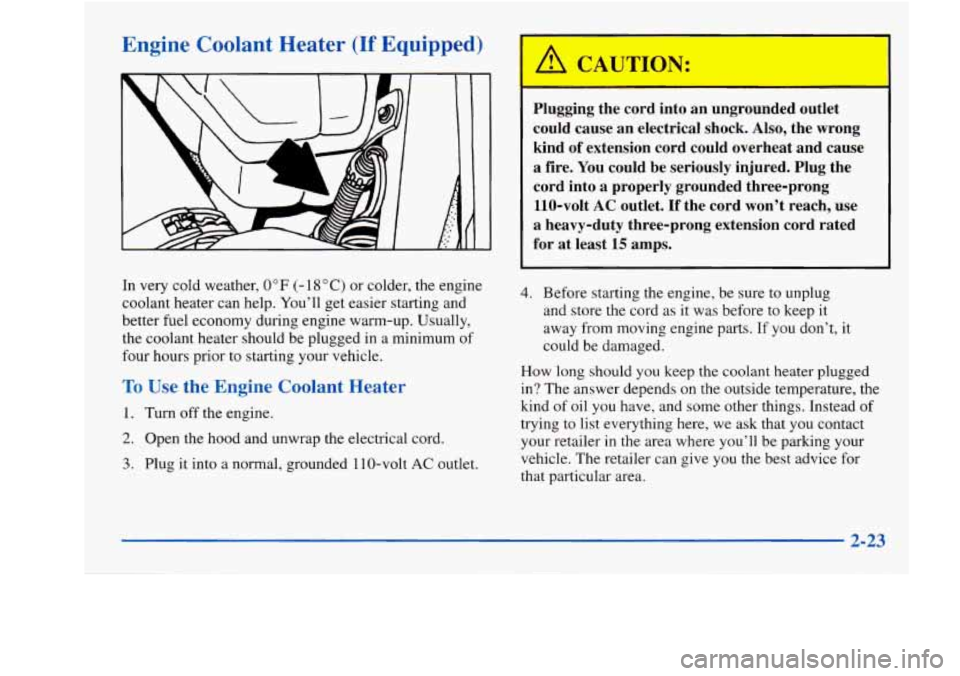
Engine Coolant Heater (If Equipped)
Plugging the cord into an ungrounded outlet
could cause an electrical shock. Also, the wrong
kind
of extension cord could overheat and cause
a fire. You could be seriously injured. Plug the
cord into
a properly grounded three-prong
110-volt
AC outlet. If the cord won’t reach, use
a heavy-duty three-prong extension cord rated
for
at least 15 amps.
In very cold weather,
0 OF (- 18 O C) or colder, the engine
coolant heater can help. You’ll get easier starting and
better fuel economy during engine warm-up. Usually,
the coolant heater should be plugged in a minimum of
four hours prior to starting your vehicle.
To Use the Engine Coolant Heater
1. Turn off the engine.
2. Open the hood and unwrap the electrical cord.
3. Plug it into a normal, grounded 1 10-volt AC outlet.
4. Before starting the engine, be sure to unplug
and store the cord as it was before to keep it
away from moving engine parts. If you don’t, it
could be damaged.
How long should you keep the coolant heater plugged
in? The answer depends on the outside temperature, the
kind of oil you have, and some other things. Instead
of
trying to list everything here, we ask that you contact
your retailer
in the area where you’ll be parking your
vehicle.
The retailer can give you the best advice for
that particular area.
2-23
Page 220 of 380
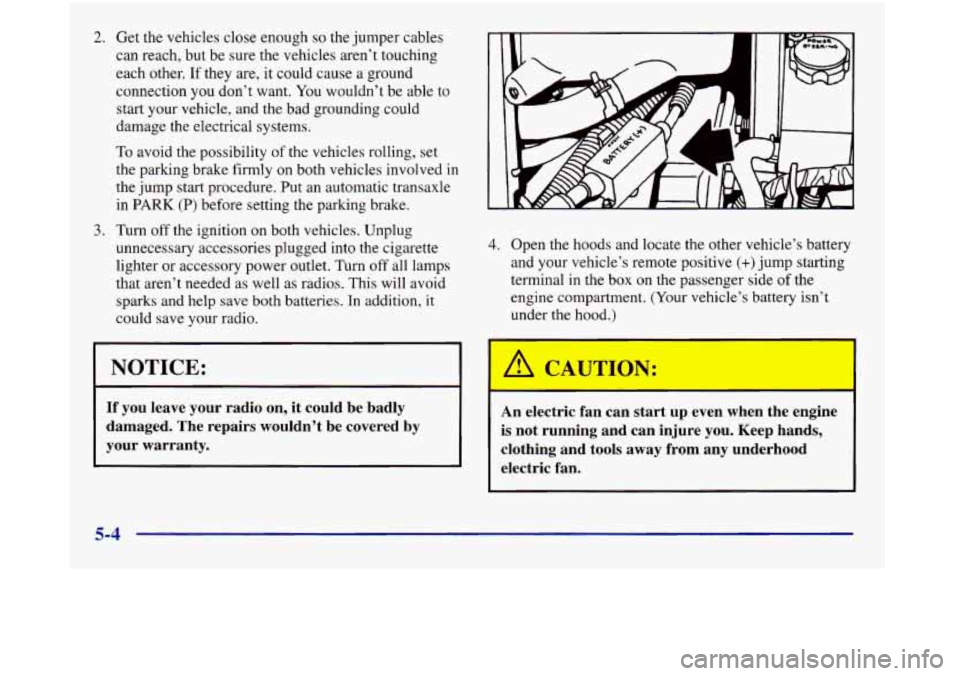
2. Get the vehicles close enough so the jumper cables
can reach, but be sure the vehicles aren’t touching
each other.
If they are, it could cause a ground
connection you don’t want. You wouldn’t be able to
start your vehicle, and the bad grounding could
damage the electrical systems.
To avoid the possibility of the vehicles rolling, set
the parking brake firmly on both vehicles involved in
the jump start procedure.
Put an automatic transaxle
in
PARK (P) before setting the parking brake.
3. Turn off the ignition on both vehicles. Unplug
unnecessary accessories plugged into the cigarette
lighter
or accessory power outlet. Turn off all lamps
that aren’t needed as well as radios. This will avoid
sparks and help save both batteries. In addition, it
could save your radio.
NOTICE:
If you leave your radio on, it could be badly
damaged. The repairs wouldn’t be covered by
your warranty.
4. Open the hoods and locate the other vehicle’s battery
and your vehicle’s remote positive (+)jump starting
terminal in the box on the passenger side
of the
engine compartment. (Your vehicle’s battery isn’t
under the hood.)
I
An electric fan can start up even when the engine
is not running and can injure you. Keep hands,
clothing and tools away from any underhood electric fan.
5-4
Page 231 of 380

If Steam Is Coming From Your Engine
Steam from an overheated engine can burn you
badly, even if you just open the hood. Stay away
from the engine if you see or hear steam coming
from it. Just turn
it off and get everyone away
from the vehicle until it cools down. Wait until
there
is no sign of steam or coolant before you
open the hood.
If you keep driving when your engine is
overheated, the liquids in it can catch fire. You
or
others could be badly burned. Stop your engine if
it overheats, and get out of the vehicle until the
engine is cool.
NOTICE:
If your engine catches fire because you keep
driving
with no coolant, your vehicle can be
badly damaged. The costly repairs would not be
covered by your warranty. See “Overheated
Engine Protection Operating Mode” in the Index.
Page 232 of 380

If No Steam - Coming From Your Engine
If you get the overheat warning but see or hear no
steam, the problem may not be too serious. Sometimes
the engine can get a little too hot when you:
Climb a long hill on a hot day.
Stop after high-speed driving.
Idle for long periods in traffic.
Tow a trailer.
If
you get the overheat warning with no sign of steam,
try this for a minute or
so:
1. Turn off your air conditioner.
2. Turn on your heater to full hot at the highest fan
speed and open the window as necessary.
3. If you’re in a traffic jam, shift to NEUTRAL (N);
otherwise, shift to the highest gear while
driving
-- AUTOMATIC OVERDRIVE (a) or
THIRD
(3).
If you no longer have the overheat warning,
you can drive. Just to be safe, drive slower for
about
10 minutes. If the warning doesn’t come back on,
you can drive normally.
If the warning continues, pull over, stop, and park your
vehicle right away.
If there’s still no sign of steam,
you can idle the engine
for two or three minutes while you’re parked, to
see if
the warning stops. But then, if
you still have the
warning,
turn ofthe engine and get everyone out of the
vehicle until it cools down. Also, see “Overheated
Engine Protection Operating Mode” listed previously in
this section.
You may decide not to lift the hood but to get service
help right away.
5-16
Page 256 of 380

If your vehicle is certified to meet California Emission
Standards (indicated on the underhood emission control
label), it is designed to operate
on fuels that meet
California specifications.
If such fuels are not available
in states adopting California emissions standards, your
vehicle will operate satisfactorily on fuels meeting
federal specifications, but emission control system
performance may be affected. The malfunction indicator
lamp on your instrument panel may turn on and/or your
vehicle may fail a smog-check test. If this occurs, return
to your authorized Aurora retailer for diagnosis to
determine the cause of failure. In the event
it is
determined that the cause of the condition is the type of
fuels used, repairs may not be covered by your warranty.
Some gasolines that are not reformulated for low
emissions contain an octane-enhancing additive called
methylcyclopentadienyl manganese tricarbonyl (MMT); ask your service station operator whether or not his fuel
contains MMT. General Motors does not recommend the
use of such gasolines.
If fuels containing MMT are used,
spark plug life may be reduced and your emission
control system performance may
be affected. The
malfunction indicator lamp on your instrument panel
may turn on.
If this occurs, return to your authorized
Aurora retailer for service. To
provide cleaner air, all gasolines in the United States
are now required
to contain additives that will help
prevent deposits from forming in your engine and
fuel system, allowing your emission control system
to
function properly. Therefore, you should not have to
add anything to the fuel. In addition, gasolines
.
containing oxygenates, such as ethers and ethanol, and
reformulated gasolines may be available in your area to
help clean the air. General Motors recommends that you
use these gasolines if they comply with the
specifications described earlier.
I NOTICE:
Your vehicle was not designed for fuel that
contains methanol. Don’t use it. It can corrode
metal parts in your fuel system and also damage
plastic and rubber parts. That damage wouldn’t
be covered under your warranty.
6-4
Page 260 of 380
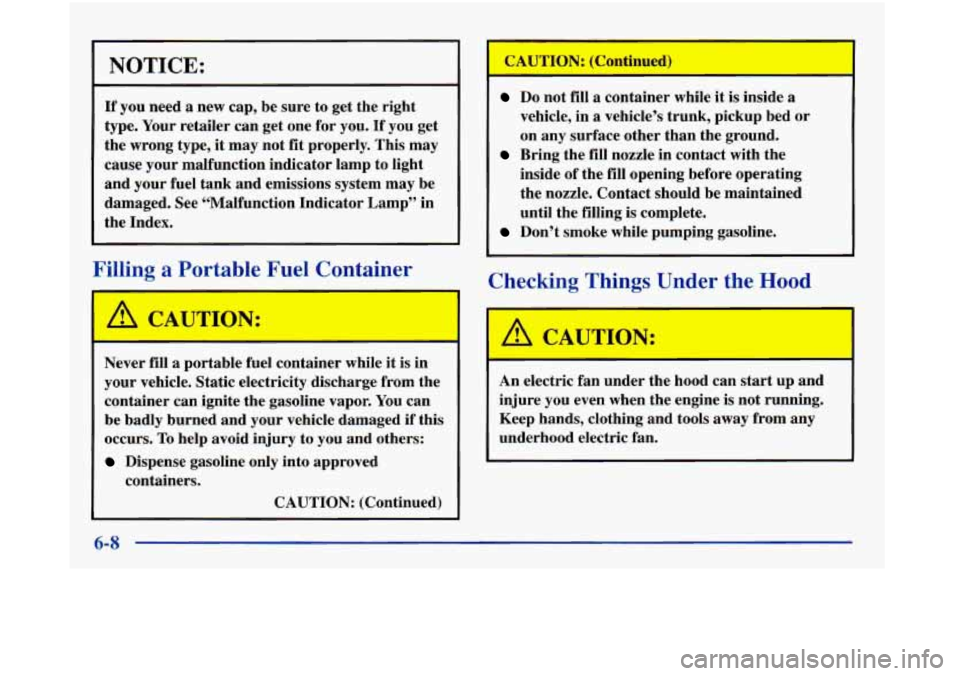
NOTICE:
If you need a new cap, be sure to get the right
type. Your retailer can get one for you.
If you get
the wrong type, it may not fit properly. This may
cause your malfunction indicator lamp to light
and your fuel tank and emissions system may be
damaged. See “Malfunction Indicator Lamp” in
the Index.
FYng a Portable Fuel Container
I-
Never fill a portable fuel container while it is in
your vehicle. Static electricity discharge from the
container can ignite the gasoline vapor. You can
be badly burned and your vehicle damaged if
this
occurs. To help avoid injury to you and others:
Dispense gasoline only into approved
containers.
CAUTION: (Continued)
I
!
Do not fill a container while it is inside a
vehicle, in a vehicle’s trunk, pickup bed or
on any surface other than the ground.
inside of the fill opening before operating
the nozzle. Contact should be maintained
until the filling is complete.
Bring the fill nozzle in contact with the
Don’t smoke while pumping gasoline.
Checking Things Under the Hood
An electric fan under the hood can start up and
injure you even when the engine is not running.
Keep hands, clothing and tools away from any
underhood electric fan.
6-8
Page 261 of 380

I A CAUTION:
Things that burn can get on hot engine parts and
start a fire. These include liquids like gasoline,
oil, coolant, brake fluid, windshield washer and
other fluids, and plastic or rubber. You or others
could be burned. Be careful not to drop or spill
things that will burn onto a hot engine.
The following sections tell you how to check fluids,
lubricants and important parts underhood.
Hood Release
To open the hood, first pull
the hood release handle
inside the vehicle, located to
the left of the steering wheel
under the instrument panel. Then
go to the front
of the vehicle and pull up on the
underhood release.
Lift the hood.
Before closing the hood, be sure
all the filler caps are on
properly. Then pull the hood down and close it fiiy.
6-9
Page 262 of 380
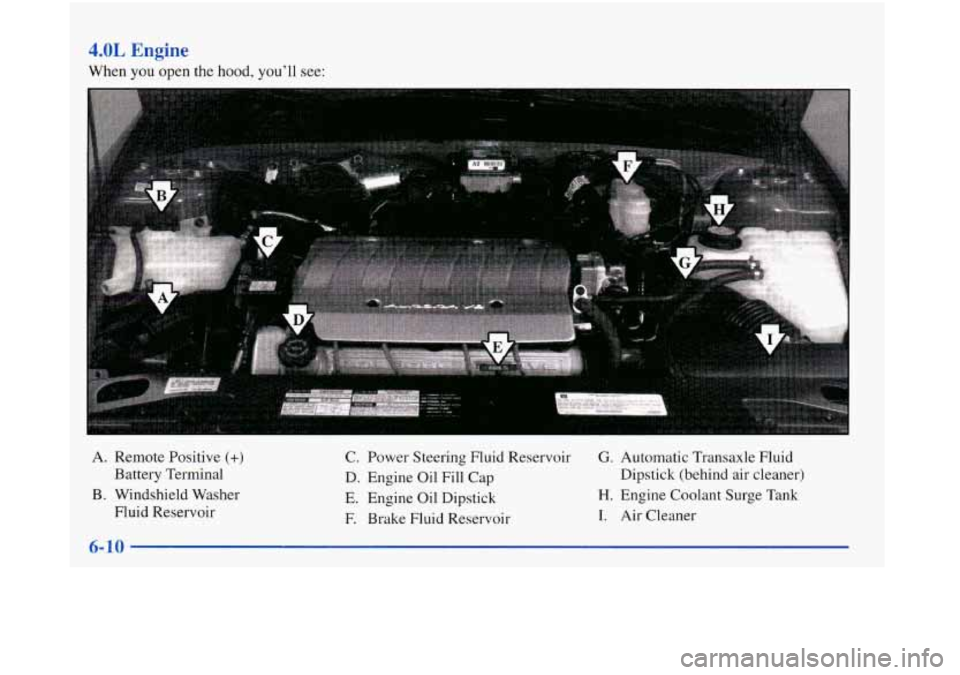
4.0L Engine
When you open the hood, you'll see:
A. Remote Positive (+)
Battery Terminal
B. Windshield Washer
fluid Reservoir
C. Power Steering Fluid Reservoir G. Automatic Transaxle Fluid
D. Engine Oil Fill Cap Dipstick
(behind air cleaner)
E. Engine Oil Dipstick H. Engine Coolant Surge Tank
E Brake Fluid Reservoir I. Air Cleaner
Page 341 of 380
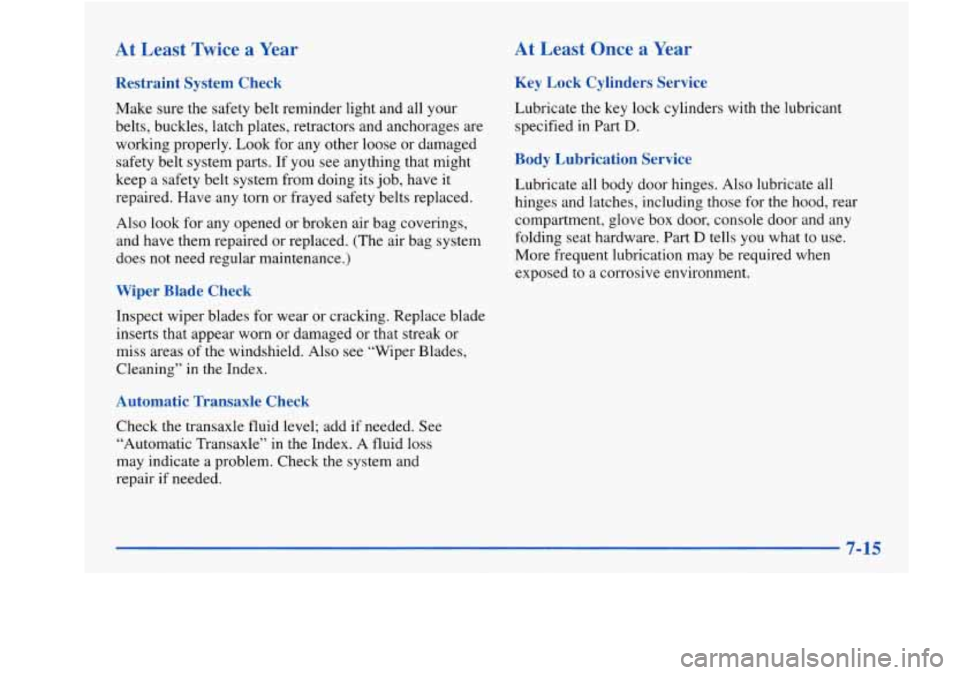
At Least Twice a Year At
Least Once a Year
Restraint System Check
Make sure me safety belt reminder light and all your
belts, buckles, latch plates, retractors and anchorages are
working properly. Look for any other loose or damaged
safety belt system parts.
If you see anything that might
keep a safety belt system from doing its job, have it
repaired. Have any torn or frayed safety belts replaced.
Also look for any opened or broken air bag coverings,
and have them repaired or replaced. (The air bag system
does not need regular maintenance.)
Wiper Blade Check
Inspect wiper blades for wear or cracking. Replace blade
inserts that appear worn or damaged or that streak or
miss areas of the windshield. Also see “Wiper Blades,
Cleaning” in
the Index.
Automatic Transaxle Check
Check the transaxle fluid level; add if needed. See
“Automatic Transaxle”
in the Index. A fluid loss
may indicate a problem. Check the system and
repair if needed.
Key Lock Cylinders Service
Lubricate the key lock cylinders with the lubricant
specified in Part
D.
Body Lubrication Service
Lubricate all body door hinges. Also lubricate all
hinges and latches, including those for the hood, rear
compartment, glove box door, console door and any
folding seat hardware. Part
D tells you what to use.
More frequent lubrication may be required when
exposed to a corrosive environment.
Page 367 of 380
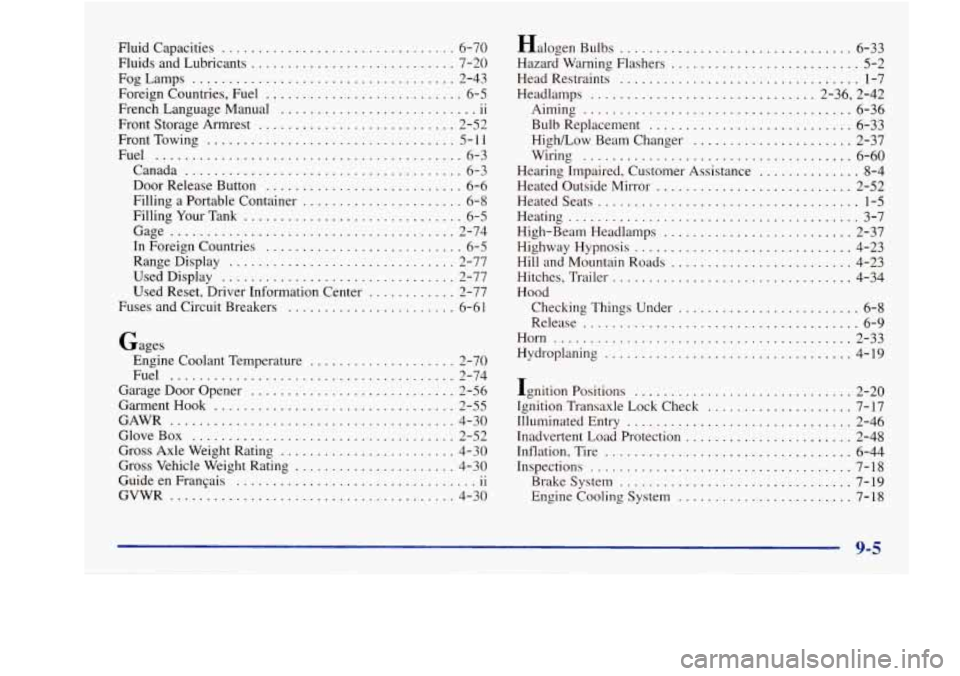
Fluid Capacities ................................ 6-70
FogLamps
.................................... 2-43
Foreign Countries. Fuel
........................... 6-5
Front Storage Armrest
........................... 2-52
Fluids and Lubricants
............................ 7-20
FrenchLanguage Manual
11
FrontTowing .................................. 5-11
Fuel
.......................................... 6-3
Canada
...................................... 6-3
Door Release Button
........................... 6-6
Filling a Portable Container
...................... 6-8
Filling Your Tank
.............................. 6-5
Gage
....................................... 2-74
In Foreign Countries
........................... 6-5
RangeDisplay
............................... 2-77
UsedDisplay
................................ 2-77
Used Reset. Driver Information Center
............ 2-77
Fuses and Circuit Breakers
....................... 6-61
.. ...........................
Gages
Engine Coolant Temperature
.................... 2-70
Fuel
....................................... 2-74
Garage Door Opener
............................ 2-56
GarmentHook
................................. 2-55
GloveBox
.................................... 2-52
Gross Axle Weight Rating
........................ 4-30
Gross Vehicle Weight Rating
...................... 4-30
Guide en Frangais
11
GAWR ....................................... 4-30
.. .................................
GVWR ....................................... 4-30 Halogen
Bulbs
................................ 6-33
Hazard Warning Flashers
.......................... 5-2
Head Restraints
................................. 1-7
Headlamps
............................... 2-36, 2-42
Aiming
..................................... 6-36
Bulb Replacement
............................ 6-33
Wiring
..................................... 6-60
High/Low Beam Changer ...................... 2-37
Hearing Impaired. Customer Assistance
.............. 8-4
Heated Outside Mirror
........................... 2-52
Heatedseats
.................................... 1-5
Heating ........................................ 3-7
High-Beam Headlamps
.......................... 2-37
Highway Hypnosis
.............................. 4-23
Hill and Mountain Roads
......................... 4-23
Hitches. Trailer
................................. 4-34
Hood Checking Things Under
......................... 6-8
Release
...................................... 6-9
Horn
......................................... 2-33
Hydroplaning
.................................. 4-19
Ignition Positions
.............................. 2-20
Ignition Transaxle Lock Check
.................... 7-17
Illuminated Entry
............................... 2-46
Inadvertent Load Protection
....................... 2-48
Inflation. Tire
.................................. 6-44
Inspections
.................................... 7-18
Brakesystem
................................ 7-19
Engine Cooling System ........................ 7-18